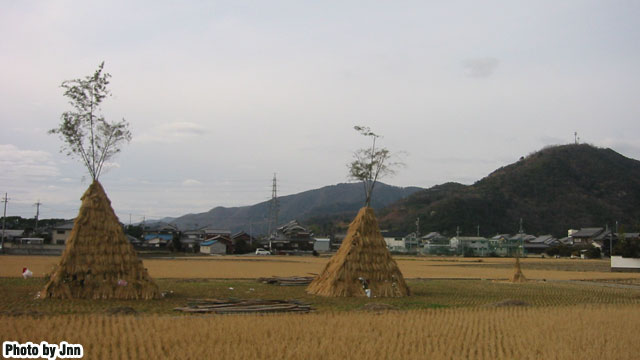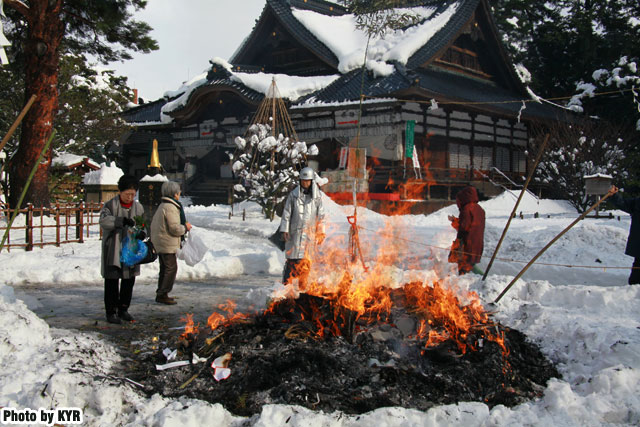Sagicho (さぎちょう or 左義長), Donto (どんと焼き) Ceremony
THE CEREMONY THAT MANY JAPANESE PEOPLE ALSO FORGET

On January 14 or 15 (or other date), Japanese conduct the ceremony called, Sagicho (さぎちょう, 左義長 or 三毬杖) or Donto-yaki (どんと焼き).
DISCLAIMER: Many places call this ceremony in different name, such as Dondo-yaki (どんどやき) or Donto (どんと). Or the different region may burn different objects in different way at the different location. You should ask your neighbor the name of this ceremony and the ritual itself
DISCLAIMER2: Many yong Japanese & the people in Tokyo may not know this ceremony either. Tokyo has been banning to conduct this ceremony due to the threat of fire since Edo-era.

Tatsuno, Hyogo, Japan in 2006
Earlier, we explained what-to-prepare during New Year's season in Japan in JLG: Get ready for New Year's Day in Japan.
You may have bought Kadomatsu, Shimenawa, and Kagamimochi.
Now the New Year comes. God leaves your house. You eat Oshiruko (Azuki Mochi Soup, おしるこ, ぜんざい, お汁粉, or 善哉) during Kagamibiraki (かがみびらき or 鏡開き) on January 11.
You now need to take care of the remaining Kadomatsu and Shimenawa.
Once God leaves your house, those holy objects become a holy garbage. But because they are still holy garbage objects, you still have to take care according to its ritual.
Sagicho is the event to burn those Kadomatsu, Shimenawa, Kakizome (かきぞめ or 書初め) or any other holy objects used during the New Year's season in Japan. (Please consult with the locals what-to-burn).
For the most Japannese, this ceremony pretty much conclude the New Year's of Japan.

Oyama Shrine, Kanazawa, Ishikawa in 2010
There are so many different way to cerebrate this ritual, please enjoy the Google Image search.
[ Search result of Sagicho at Google Image ]
If you bought Kadomatsu or Shimenawa, and don't just want to throw away. Do a research and find out when, where, how Sagicho takes place in your area.
Unfortunately, because they deal with fire, many places, especially inner-city, stopped conducting this ceremony. If you cannot find the Sagicho ceremony in your neighborhood, simply throw it away as Nandemo Gomi (なんでもごみ). Or go to the local shrine, and talk to someone there.
UPDATES: Variations
After posting this article, many Japanese starts giving me their variation of Sagicho (or Donto) ceremony. Here are some variations.
Keeping it
According to Kaze-san from Suzuka, Japan, he keeps his Shimenawa until the next New Year's Day. The local shrine makes the fire from New Year's Eve until New Year's Day. He bring the old Shimenawa to the holy fire of New Year's Day in the following year.
Shrine May Have a Box
Some shrines may set-up a box to return the Shimenawa. Lately, Shimenawa use plastic decoration which should not be burned. Therefore, you can separate the rice rope and plastic, or turn everything into a box. So "go to the local shrine" is the best first step.
Japanese Quick Guide
If you want to ask your neighbor, you can simply pring this out, & present this language sheet.
Q: Do you know if our neighbor has Sagicho (or Donto-yaki) ceremony that burns Kadomatsu or Shimenawa
Q: この辺りで、門松やしめ縄を焼く、左義長(どんと焼き)をやっているのかご存知ですか?
Q: このあたりで、かどまつ や しめなわを やく、さぎちょう(どんとやき)をやっているのか ごぞんじですか?
Q: If so, would you tell me where, and when?
Q: もし、そうであれば、いつ、どこで、開催しているのか、教えてくれませんか?
Q: もし、そうであれば、いつ、どこで、かいさいしているのか、おしえてくれませんか?
When you arrive on-site, DON'T GET CLOSER to the fire by yourself! Ask anybody there. They will help you.
Q: Can you help me burn my Kadomatsu and/or Shimenawa?
Q: 門松 / と / しめ縄 を燃やしたいのですが、助けてただけませんか?
Q: かどまつ / と / しめなわ を もやしたいのですが、助けていただけませんか?
You couldn't find any Sagicho ceremony in your neighborhood, but still don't want to throw it away. Go to the local shrine, and ask someone the following question.
Q: I'm looking for any help to take care of my Kadomatsu / and / or / Shimenawa because our neghbor doesn't have Sagicho ceremony. But I don't want to throw it away simply. Can you help me to get rid of these?
Q: この辺りで、左義長やどんと焼きのような風習がないのは分かっていますが、どうしても自分で捨てることができないので、この門松やしめ縄の処分する良い方法を教えてくれませんか?
You are now one step closer to become a Inaka-mono (country Japanese)
####
Related Articles
- JLG: Get ready for New Year's Day in Japan
- Hatsuhinode (The First Sunrise) of 2011 from Suzuka, Japan
- Nanakusa-gayu (七草粥)
- YokosoNews on Facebook (occational updates & photos during New Year's season)